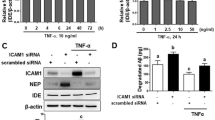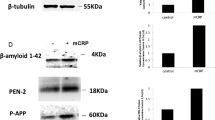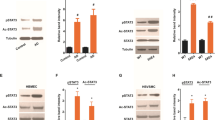Abstract
The pathological hallmarks of Alzheimer’s disease (AD) include formation of extracellular amyloid-β peptide (Aβ) and inflammatory responses. Numerous studies have reported that cerebral microvascular Aβ deposition promotes neuroinflammation in AD. Matrix metalloproteinases (MMPs) are involved in the cleavage of extracellular matrix proteins and regulation of growth factors, receptors, and adhesion molecules. Relatively little is known about the involvement of MMPs as inflammatory mediators in the pathological processes of AD. In this study, we explored the signaling pathway of MMP-2 up-regulation by Aβ in brain endothelial cells (BECs) of mice. Using Western blots, we found that inhibitors of extracellular-signal-regulated kinases (ERK) and c-Jun N-terminal kinase (JNK) significantly decreased Aβ-induced MMP-2 expression in BECs. Furthermore, antibody neutralization of the receptor for advanced glycation endproducts effectively blocked Aβ-induced activation of ERK and JNK and their contribution to elevated MMP-2 expression in BECs. Our results suggest that increased MMP-2 expression induced by the interaction of Aβ with RAGE in BECs may contribute to enhanced vascular inflammatory stress in Aβ-related vascular disorders, such as cerebral amyloid angiopathy and AD. This study offers new insights into neuroinflammation in the progression of AD.



Similar content being viewed by others
References
Atterns J, Jellinger KA (2004) Only cerebral capillary amyloid angiopathy correlates with Alzheimer pathology—a pilot study. Acta Neuropathol 107:83–90
Bailey TL, Rivara CB, Rocher AB, Hof PR (2004) The nature and effects of cortical microvascular pathology in aging and Alzheimer’s disease. Neurol Res 26:573–578
Basta G (2008) Receptor for advanced glycation end products and atherosclerosis: from basic mechanisms to clinical implications. Atherosclerosis 196:9–21
Chen X, Walker DG, Schmidt AM, Arancio O, Lue LF, Yan SD (2007) RAGE: a potential target for Abeta-mediated cellular perturbation in Alzheimer’s disease. Curr Mol Med 7:735–742
De la Torre JC (2002) Alzheimer disease as a vascular disorder: nosological evidence. Stroke 33:1152–1162
Deane R, Zlokovic BV (2007) Role of the blood-brain barrier in the pathogenesis of Alzheimer’s disease. Curr Alzheimer Res 4:191–197
Du H, Li P, Pan Y, Li W, Hou J, Chen H, Wang J, Tang H (2010) Vascular endothelial growth factor signaling implicated in neuroprotective effects of placental growth factor in an in vitro ischemic model. Brain Res 1357:1–8
Engelhart MJ, Geerlings MI, Meijie J, Kiliaan A, Ruitenberg A, van Swieten JC, Stijnen T, Hofman A, Witteman JC, Breteler MM (2004) Inflammatory proteins in plasma and the risk of dementia: the Rotterdam study. Arch Neurol 61:668–672
Frisch SM, Ruoslahti E (1997) Integrins and anoikis. Curr Opin Cell Biol 9:701–706
Girones X, Guuimera A, Cruz-Sanchez CZ, Ortega A, Sasaki N, Makita Z, Lafuente JV, Kalaria R, Cruz-Sanchez FF (2004) N epsilon carboxymethyllysine in brain aging, diabetes mellitus, and Alzheimer’s disease. Free Radic Biol Med 36:1241–1247
Golde TE, Eckman CB, Younkin SG (2000) Biochemical detection of Abeta isoforms: implications for pathogenesis, diagnosis, and treatment of Alzheimer’s disease. Biochem Biophys Acta 1502:172–187
Greenberg SM, Gurol ME, Rosand J, Smith EE (2004) Amyloid angiopathy related vascular cognitive impairment. Stroke 35:2616–2619
Hardy J, Cullen K (2006) Amyloid at the blood vessel wall. Nat Med 12:756–757
Harja E, Bu DX, Hudson BI, Chang JS, Shen X, Hallam K, Kalea AZ, Lu Y, Rosario RH, Oruganti S, Nikolla Z, Belov D, Lalla E, Ramasamy R, Yan SF, Schmidt AM (2008) Vascular and inflammatory stresses mediate atherosclerosis via RAGE and its ligands in apoE-/- mice. J Clin Invest 118:183–194
Hofmann MA, Drury S, Fu C, Qu W, Taguchi A, Lu Y, Avila C, Kambham N, Bierhaus A, Nawroth P, Neurath MF, Slattery T, Beach D, McClary J, Nagashima M, Morser J, Stern D, Schmidt AM (1999) RAGE mediates a novel proinflammatory axis: a central cell surface receptor for S100/calgranulin polypeptides. Cell 97:889–901
Kawai M, Kalaria RN, Harik SI, Perry G (1990) The relationship of amyloid plaques to cerebral capillaries in Alzheimer’s disease. Am J Pathol 137:1435–1446
Koyama H, Yamamoto H, Nishizawa Y (2007) RAGE and soluble RAGE: potential therapeutic targets for cardiovascular disease. Mol Med 13:625–635
Li M, Shang DS, Zhao WD, Tian L, Li B, Fang WG, Zhu L, Man SM, Chen YH (2009a) Amyloid βinteraction with receptor for advanced glycation end production upregulates brain endothelial CCR5 expression and promotes T cells crossing the blood-brain barrier. J Immunol 182:5778–5788
Li W, Li P, Hua Q, Hou J, Wang J, Du H, Tang H, Xu Y (2009b) The impact of paracrine signaling in brain microvascular endothelial cells on the survival of neurons. Brain Res 1287:28–38
Li W, Poteet E, Xie L, Liu R, Wen Y, Yang SH (2011) Regulation of matrix metalloproteinase 2 by oligomeric amyloid βprotein. Brain Res 1387:141–148
Lorenzl S, Albers DS, LeWitt PA, Chirichigno JW, Hilgenberg SL, Cudkowicz ME, Beal MF (2003) Tissue inhibitors of matrix metalloproteinases are elevated in cerebrospinal fluid of neurodegenerative disease. J Neurol Sci 207:71–76
Lue LF, Yan SD, Stern DM, Walker DG (2005) Preventing activation of receptor for advanced glycation endproducts in Alzheimer’s disease. Curr Drug Targets CNS Neurol Disord 4:249–266
McGeer EG, McGeer PL (2003) Inflammatory processes in Alzheimer’s disease. Prog Neuropsycholpharmacol Biol Psychiatry 27:741–749
McGeer PL, Akiyama H, Itagaki S, McGeer EG (1989) Immune system response in Alzheimer’s disease. Can J Neurol Sci 16:516–527
Mizoguchi H, Takuma K, Fukuzaki E, Ibi D, Someya E, Akazawa K, Alkam T, Tsunekawa H, Mouri A, Noda Y, Nabeshima T, Yamada K (2009) Matrix metalloprotease-9 inhibition improves amyloid β-mediated cognitive impairment and neurotoxicity in mice. J Pharmacol Exp Ther 331:14–22
Mlekusch R, Humpel C (2009) Matrix metalloproteinases-2 and -3 are reduced in cerebrospinal fluid with low beta-amyloid1–42 levels. Neurosci Lett 466:135–138
Mun-Bryce S, Lukes A, Wallace J, Lukes-Marx M, Rosenberg GA (2002) Stromelysin-1 and gelatinase A are upregulated before TNF-α in LPS-stimulated neuroinflammation. Brain Res 933:42–49
Ramasamy R, Vannucci SJ, Yan SD, Herold K, Yan SF, Schmidt AM (2005) Advanced glycation end products and RAGE: a common thread in aging, diabetes, neurodegeneration and inflammation. Glycobiology 15:16R–28R
Schmidt AM, Yan SD, Yan SF, Stern DM (2001) The multiligand receptor RAGE as a progression factor amplifying immune and inflammatory responses. J Clin Invest 108:949–955
Tagliavini F, Ghiso J, Timmers WF, Giaccone G, Bugiani O, Frangione B (1990) Coexistence of Alzheimer’s amyloid precursor protein and amyloid protein in cerebral vessel walls. Lab Invest 62:761–767
Tarkowski E (2002) Cytokines in dementia. Curr Drug Targets Inflamm Allergy 1:193–200
Van den Steen PE, Dubois B, Nelissen I, Rudd PM, Dwek RA, Opdenakker G (2002) Biochemistry and molecular biology of gelatinase B or matrix metalloproteinase-9. Crit Rev Biochem Mol Biol 37:375–536
Vinters HV (2001) Cerebral amyloid angiopathy: a microvascular link between parenchymal and vascular dementia? Ann Neurol 49:691–692
Wang H, Ward N, Boswell M, Katz DM (2006) Secretion of Brain-derived neurotrophic factor from brain microvascular endothelial cells. Eur J Neurosci 23:1665–1670
Yan SD, Chen X, Fu J, Chen M, Zhu H, Roher A, Slattery T, Zhao L, Nagashima M, Morser J, Migheli A, Nawroth P, Stern D, Schmidt AM (1996) RAGE and amyloid-beta peptide neurotoxicity in Alzheimer’s disease. Nature 382:685–691
Yan SD, Zhu H, Fu J, Yan SF, Roher A, Tourtellotte WW, Rajavashisth T, Chen X, Goldman GC, Stern D, Schmidt AM (1997) RAGE–Aβ interaction elicits neuronal expression of macrophage-colony stimulating factor: a proinflammatory pathway in Alzheimer disease. Proc Natl Acad Sci USA 94:5296–5301
Yankner BA (1996) Mechanisms of neuronal degeneration in Alzheimer’s disease. Neuron 16:921–932
Yong VW, Power C, Forsyth P, Edwards DR (2001) Metalloproteinases in biology and pathology of the nervous system. Nat Rev Neurosci 2:502–511
Acknowledgments
The Grant sponsors are from Ministry of Education and Key laboratory of Chinese Internal Medicine; The National Basic Research Program (Grant No. 2005CB523311); The National significant science and technology special projects (Grant No. 2009ZX0950214).
Author information
Authors and Affiliations
Corresponding author
Rights and permissions
About this article
Cite this article
Du, H., Li, P., Wang, J. et al. The Interaction of Amyloid β and the Receptor for Advanced Glycation Endproducts Induces Matrix Metalloproteinase-2 Expression in Brain Endothelial Cells. Cell Mol Neurobiol 32, 141–147 (2012). https://doi.org/10.1007/s10571-011-9744-8
Received:
Accepted:
Published:
Issue Date:
DOI: https://doi.org/10.1007/s10571-011-9744-8




